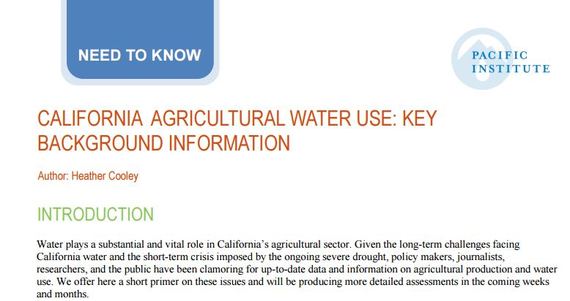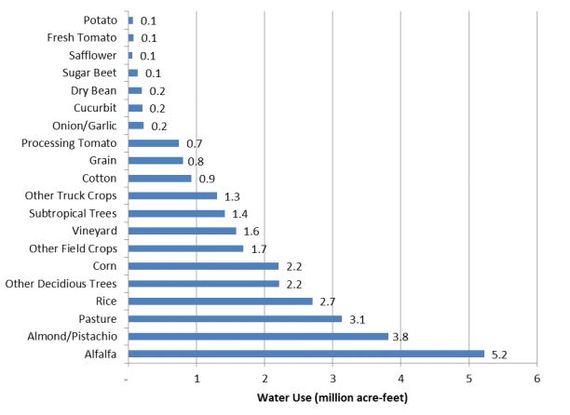By Peter Gleick, President
Water plays a vital role in California’s agricultural sector, using 80% of the water used by humans in the state. In recent months, water challenges imposed by the current severe drought have brought this agricultural water use into the limelight, raising new questions about how the water is used. A new “Need to Know” brief authored by Heather Cooley and the Pacific Institute, provides essential background information on the state’s agricultural water use: in particular, the brief estimates total water applied for crops grown in California, the water intensity of those crops, and the economic productivity of water.
Among the key findings are that alfalfa is the largest single consumer of water, using over 5 million acre-feet per year (in 2010 – the last year for which consistent and comprehensive data are available), and produces about farm revenue of around $175 per acre-foot of water. Almonds and pistachios together use around 3.3 million acre-feet of water and produce around $1,150 per acre-foot of water. (An acre-foot of water is around 326,000 gallons, or the amount of water needed to cover an acre to a depth of a foot.)
These indices for a range of crops are shown in Figures 1 and 2 below, and details on the full analysis are in the report, available free from the Pacific Institute.
Figure 1. Water applied to crops, in acre-feet per year (2010). Used with permission.
Figure 2. Revenue by crop, in $ per acre-foot. Used with permission.
Questions around agricultural water policy are complicated and the report clearly describes these different factors. Heather Cooley notes, for example, that while these values
“provide some insight into choices that farmers make, agricultural decisions cannot be made based only on economic productivity numbers. No one would propose, for example, that only vineyards be planted because of its high value per unit water or that no field crops be grown in California.”
The report also notes that there are large uncertainties in agricultural water use due to a lack of consistent measurement and reporting, time lags in information, and confusion about definitions. Data on agricultural production and water use are not collected at all, or are collected by individual irrigation districts, counties, and a variety of state and federal agencies using a range of tools from voluntary reporting at the field level to remote sensing from satellites. Additional estimates of water use come not from actual observations or reposting but from model estimates and other techniques for projecting use.
The report argues that in order to truly understand the risk and opportunities for water use in California, more and better data are needed.
Pacific Institute Insights is the staff blog of the Pacific Institute, one of the world’s leading nonprofit research groups on sustainable and equitable management of natural resources. For more about what we do, click here. The views and opinions expressed in these blogs are those of the authors and do not necessarily reflect an official policy or position of the Pacific Institute.
This blog was originally published in Huffington Post. You may find the original article here.





